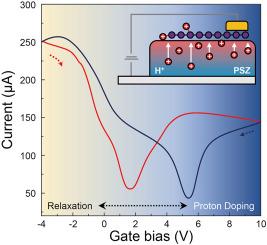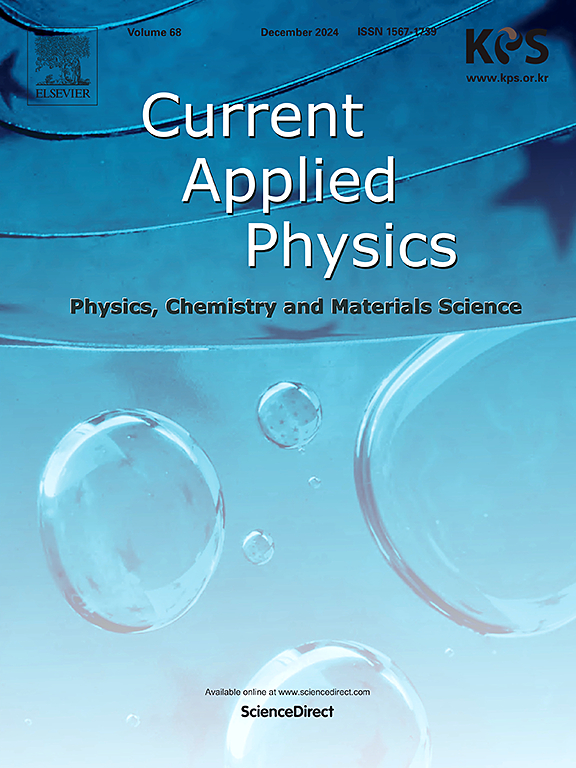质子掺杂石墨烯fet的离子调制从聚硅氮烷电介质
IF 3.1
4区 物理与天体物理
Q3 MATERIALS SCIENCE, MULTIDISCIPLINARY
引用次数: 0
摘要
由于石墨烯的高载流子迁移率和原子尺度厚度,石墨烯场效应晶体管为下一代电子产品提供了巨大的潜力。然而,稳定的器件运行需要精确控制介电界面,这会影响载流子输运和掺杂。在这项研究中,我们使用溶液处理的聚硅氮烷(PSZ)衍生的电介质作为栅极绝缘体和活性离子环境来调节石墨烯的电子特性。在潮湿条件下加工的PSZ薄膜产生富含羟基的表面,作为质子储存器。电学表征和原位拉曼光谱分析表明,栅极偏压诱导石墨烯的质子掺杂,表现为迟滞、狄拉克点位移和声子激活和界面库仑扰动引起的d波段增强。该装置还显示出特有的掺杂和弛豫时间,揭示了质子迁移动力学。我们的研究结果表明,PSZ介电材料提供了栅极绝缘和石墨烯通道的动态电化学调制,为二维电子器件的介电界面工程提供了一种新的策略。本文章由计算机程序翻译,如有差异,请以英文原文为准。

Proton doping of graphene FETs enabled by ionic modulation from polysilazane dielectrics
Graphene field-effect transistors offer great potential for next-generation electronics due to graphene's high carrier mobility and atomic-scale thickness. However, stable device operation requires precise control of the dielectric interface, which impacts carrier transport and doping. In this study, we use solution-processed polysilazane (PSZ)-derived dielectrics as both gate insulators and active ionic environments for modulating graphene's electronic properties. The PSZ films, processed under humid conditions, generate hydroxyl-rich surfaces that serve as proton reservoirs. Electrical characterization and in-situ Raman spectroscopy show that gate bias induces proton doping of graphene, manifesting as hysteresis, Dirac point shifts, and D-band enhancement arising from phonon activation and interfacial Coulombic perturbations. The device also exhibits characteristic doping and relaxation times, revealing proton migration dynamics. Our findings suggest that PSZ dielectrics provide both gate insulation and dynamic electrochemical modulation of the graphene channel, offering a new strategy for dielectric interface engineering in 2D electronic devices.
求助全文
通过发布文献求助,成功后即可免费获取论文全文。
去求助
来源期刊

Current Applied Physics
物理-材料科学:综合
CiteScore
4.80
自引率
0.00%
发文量
213
审稿时长
33 days
期刊介绍:
Current Applied Physics (Curr. Appl. Phys.) is a monthly published international journal covering all the fields of applied science investigating the physics of the advanced materials for future applications.
Other areas covered: Experimental and theoretical aspects of advanced materials and devices dealing with synthesis or structural chemistry, physical and electronic properties, photonics, engineering applications, and uniquely pertinent measurement or analytical techniques.
Current Applied Physics, published since 2001, covers physics, chemistry and materials science, including bio-materials, with their engineering aspects. It is a truly interdisciplinary journal opening a forum for scientists of all related fields, a unique point of the journal discriminating it from other worldwide and/or Pacific Rim applied physics journals.
Regular research papers, letters and review articles with contents meeting the scope of the journal will be considered for publication after peer review.
The Journal is owned by the Korean Physical Society.
 求助内容:
求助内容: 应助结果提醒方式:
应助结果提醒方式:


